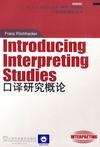口译研究概论
出版时间:2009-12 出版社:上海外语教育出版社 作者:刜兰茨·波契哈克 页数:252
Tag标签:无
内容概要
《口译研究概论》的全书分三个部分:第一部分“理论基础”(Foundations)介绍口译研究的基本概念、历史沿革、研究路径、研究范式、口译模式等。第二部分“选题及研究”(Selected topics and research)讨论口译研究的四个主要方面,包括口译过程研究、口译产品及译员表现研究、口译实践与职业研究、口译教学研究等。 第三部分“研究趋向”(Directions)对口译研究的学科发展态势和关键问题进行扼要总结,并对今后口译研究的发展趋势和路径作出预测。
作者简介
刜兰茨·波契哈克(Franz.Pǎchhacker)博士现任奥地利维也纳大学翻译学研究中心副教授,学术期刊《口译》(Interpreting)的主编之一,是当今本方较有影响力的口译研究者。
书籍目录
List of figuresAcknowledgementsIntroducing Introducing…PART I Foundations 1 Concepts 1.1 Conceptual roots 1.2 Interpreting defined 1.3 Settings and constellations 1.4 Typological parameters 1.5 Domains and dimensions 2 Evolution 2.1 Socio-professional underpinnings 2.2 Breaking ground: professionals and psychologists 2.3 Laying academic foundations 2.4 Renewal and new beginnings 2.5 Consolidation and integration 2.6 Interpreting studies in the twenty-first centuy 3 Approaches 3.1 Disciplinary perspectives 3.2 Memes of interpreting 3.3 Methodology 4 Paradigms 4.1 The notion of ‘paradigm' 4.2 Forging a paradigm 4.3 Experimenting with interpreting 4.4 Aspiring to science 4.5 Broadening the view 4.6 Focusing on interaction 4.7 Unity in diversity 5 Models 5.1 On modeling 5.2 Socio-professional and institutional models 5.3 Interaction models 5.4 Processing models 5.5 Models, tests and applicationsPART II Selected topics and research 6 Process 6.1 Bilingualism 6.2 Simultaneity 6.3 Comprehension 6.4 Memory 6.5 Production 6.6 Input variables 6.7 Strategies 7 Product and performance 7.1 Discourse 7.2 Source-target correspondence 7 3 Effect 7.4 Role 7.5 Quality 8 Practice and profession 8.1 History 8.2 Settings 8.3 Standards 8.4 Competence 8.5 Technology 8.6 Ecologyl 8.7 Sociology 9 Pedagogy 9.1 Curriculum 9.2 Selection 9.3 Teaching 9.4 Assessment 9.5 Meta-level trainingPART III Directions 10 Directions 10.1 Trends 10.2 Perspectives 10.3 OrientationBibliographyInternet linksAuthor indexSubject index
章节摘录
In this institutional context,pioneering professionals produced the first textbooksof interpreting (Herbert 1952, Rozan 1956, van Hoof 1962, Seleskovitch 1968), and(conference) interpreter training programs throughout the 1970s and 1980sforegrounded the professional rather than the academic dimension of higher education.Ever since the 1980s, though, there has been a trend in many institutions toward whatMackintosh (1999: 73) calls “a more theory-friendly curriculum”: CIUTI has come tostress the dual identity of interpreter (and translator) education as being both orientedtowards professional practice and guided by academic research; more and moreinterpreter trainers have been taking an interest in research (to enhance their teachingor their academic career opportunities, or both); interpreting students have becomeincreasingly exposed to theoretical analysis and reflection; some T/I schools havebeen more closely integrated with research-oriented departmental structures; and manystudents have completed graduation theses devoted to interpreting research. Mostimportandy, interpreting has increasingly become accepted as a subject worthy ofdoctoral research, and there has been a steady output of PhD theses, whose role infueling the development of interpreting studies as an academic discipline can hardlybe overestimated.
编辑推荐
《口译研究概论》是一部编排科学的口译研究入门教材,对口译研究的理论基础、选题及其研究方法以及研究趋向等进行了庞而不杂、条理清晰的综述,是口译研究的学科理论奠基之作。该书自出版以来在翻译研究界及口译研究界均受到高度评价。翻译研究界的代表人物莫纳·贝克(Mona Baker)称,“这本以读者为本的实用教科书是口译研究这门重要的新兴学科的一个权威路线图。”国际口译界的最大行业组织“国际译员协会”(AIIC)也发表评论称,“该书的出版是对口译研究领域的一大贡献。”
图书封面
图书标签Tags
无
评论、评分、阅读与下载
用户评论 (总计6条)
- 虽然的确是泛泛而谈,但是却面面聚到,对于宏观掌控研究可能性的目的而言还是受益匪浅的。
- 对口译学习应该挺有帮助
- 不愧是大师兄...
- 这套教材对于口译训练确实大有裨益。如果有配套译本就更好了。
- 与英文版的配套一起读更便于理解.
- 引进版 很好啊
推荐图书
- 苏南乡镇政权建设研究(第1卷)
- 中国化妆品大全 (平装)
- ラスト?セメタリー
- 2010年国家司法考试历年真题归类自测及详解1-8(套装共8册)
- 中国产权市场年鉴2004 (平装)
- 胡达源集
- 走出健康认知的误区
- わるいやつら 下 新潮文庫 ま 1-9
- 韓国ドラマ&シネマLIVE純愛ドラマSPECIAL
- 自由面面观
- HAUTE COUTURE COLLEC
- 素敵なミセス 2009春夏
- 检察官犬神
- 極厚愛蔵版 金田一少年の事件簿
- ロンドン〈2000‐2001年版〉
- 温泉&やど九州 ’10
- 小学生领先一步学科学
- まひる野〈下〉
- 同步解析与测试:高中英语(高三第3册下) (平装)
- 席勒的人本主义美学
- 51单片机自学笔记
- D06 地球の歩き方 成都?九寨溝?麗江 四川?雲南?貴州の自然と民族 2009~2010
- 矢量年华
- 新素描
- 天地人 前編
相关图书
- 初中综合实践活动教材:家政篇 (平装)
- なぜ飼い犬に手をかまれるのか
- 東京大好き!
- 公主传奇
- ゲームの魔法
- 死の器〈下〉
- 粗糙集理论及其数据挖掘应用
- 2011中考全真·模拟测试卷
- 第二次世界大战风云录-外交角逐 (平装)
- KOREAN WAVE 36―韓国TV&スターズ
- 高校鉄拳伝タフ 35
- 不安的初啼(改版)
- 最新版 肉料理の技術―牛肉?豚肉?仔羊肉?鶏肉?鴨肉
- 武平县志
- 李达
- 过于喧嚣的孤独
- ツバサ 25―RESERVoir CHRoNiCLE
- 夜航十年
- かぎ針で編む夏こもの―かぎ針1本でさくさく編みたい爽やかでかわいいこものがいっぱい!
- (13春)能力拓展课时练小学语文五年级下
- 近代西藏巨商"邦达昌"之邦达•多吉的政治生涯与商业历程 (平装)
- 00540外国文学史·自学考试指导与题解
- ケースオフィサー 上―警察庁国際テロリズム対策課
- 电子测量与仪器
- 25ansウエデイングジュエリー 2009
